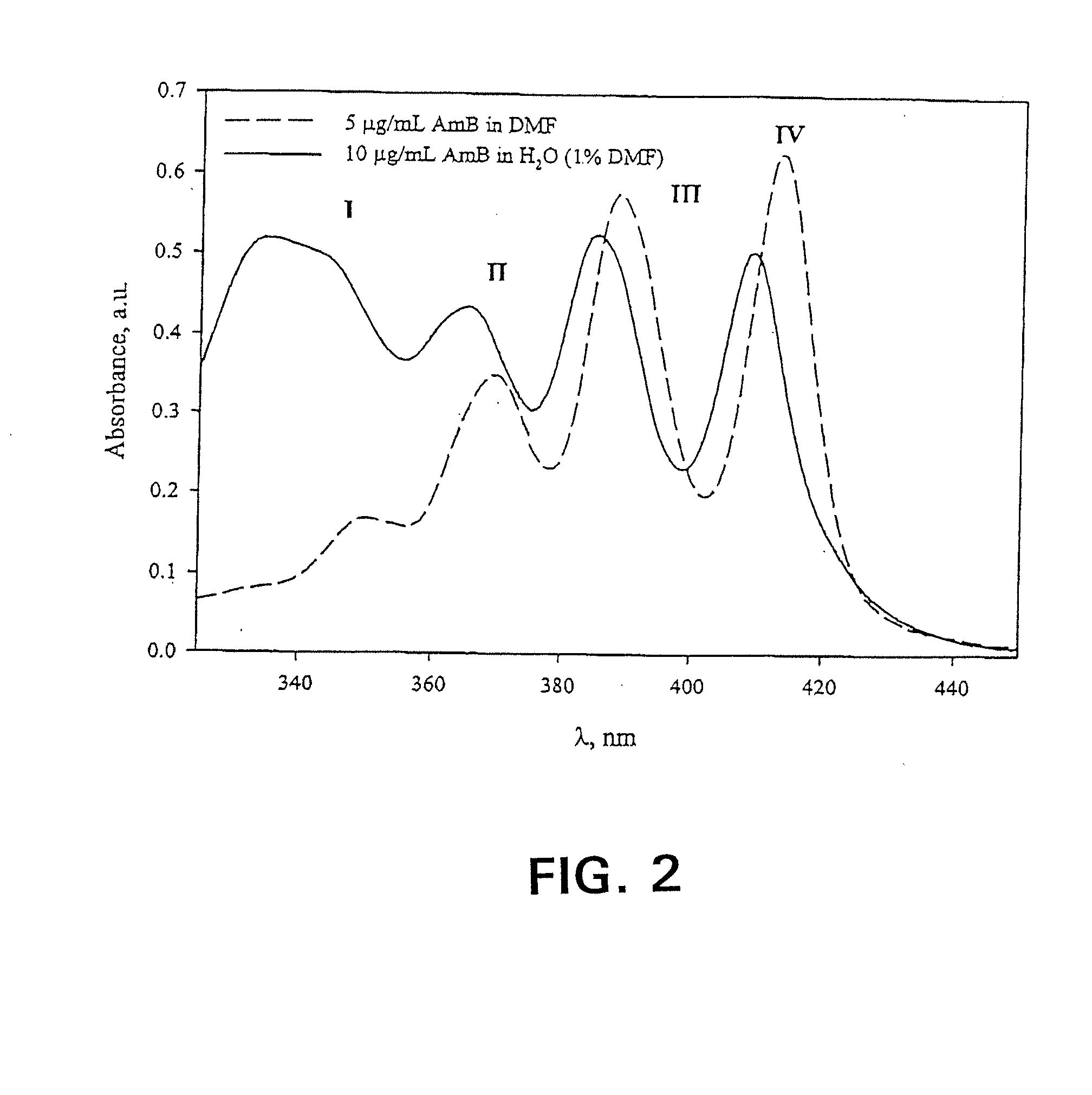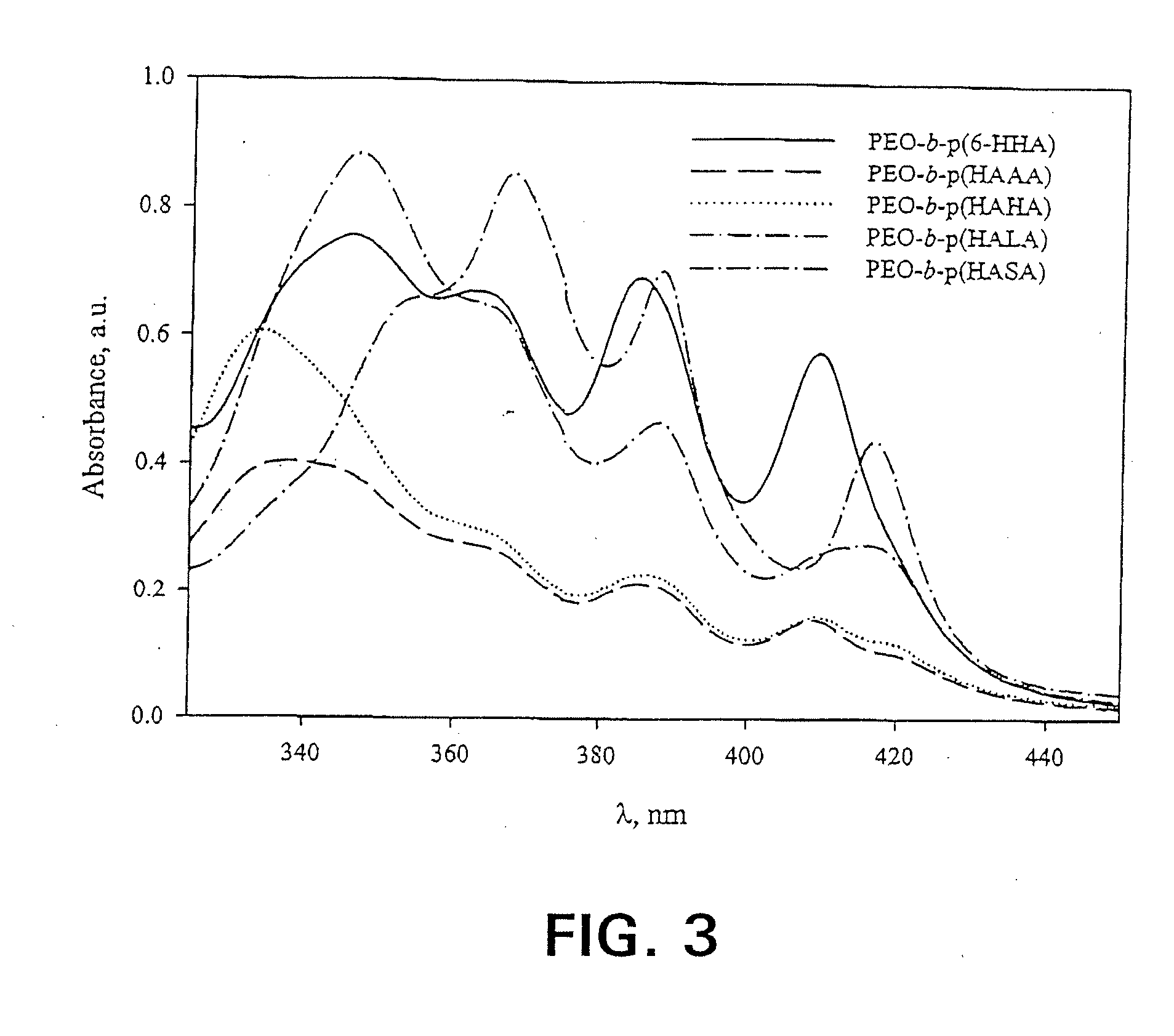Polymeric Micelle Formulations of Hydrophobic Compounds and Methods
a technology of hydrophobic compounds and micelles, which is applied in the field of hydrophobic compound formulating methods, can solve the problems of increasing treatment costs, affecting the safety of patients, and difficult formulations for oral administration, and achieves the effect of reducing toxicities
- Summary
- Abstract
- Description
- Claims
- Application Information
AI Technical Summary
Benefits of technology
Problems solved by technology
Method used
Image
Examples
example 1
Preparation of Methoxy Poly(ethylene glycol)-block-poly(6-hydroxyhexyl-L-aspartamide)-Acyl Conjugates, PEG-b-p(HAZA)
[0080]For simplicity, the hydrophilic blocks are referred to as PEG although the blocks are actually methoxy poly(ethylene glycol), mPEG or PEG. The preparation of methoxypoly(ethylene glycol)-block-poly(6-hydroxyhexyl-L-aspartamide), PEG-b-p(6-HHA) and methoxy poly(ethylene glycol)-block-poly(N-hexyl-L-aspartamide)-Z-acid conjugates, PEG-b-p(HAZA) was described (Adams, M. L. et al. (2002) J. Biomat. Sci., Polym. Ed. 13, 991). Briefly, methoxypoly(ethylene glycol)-block-poly(□-benzyl-L-aspartate), PEG-b-PBLA, 12:25 (Nanocarrier, Kashiwashi Ciba, JP), containing a PEG molecular weight of 12,000 g / mol and an average of 25 Asp repeat units was reacted with 6-amino-1-hexanol in freshly distilled dimethylformamide (DMF) in the presence of 2-hydroxypyridine to prepare PEG-b-p(6-HHA). This product was esterified at ambient temperature with excess stearic, lauric, or hexanoic ...
example 2
Drug Loading
[0083]80 mg of PEG-b-p(6-HHA) or 5 mg of PEG-b-p(HAZA) was dissolved in 2.0 mL of methanol (MeOH) containing 0.3125 mg / mL of AmB (Chem-Impex, Wood Dale, Ill.). Distilled water (d.H2O) was added dropwise to the stirring solution at a rate of 0.075-0.090 mL / min (1 drop / 10-12 s) to obtain a 50:50 MeOH:d.H2O mixture. An additional 1 mL of d.H2O was added to the stirring solution. All samples were sonicated as necessary to obtain clear solutions. Trehalose dihydrate (0.75 g) was then dissolved in the 40:60 MeOH:d.H2O polymer mixture. In the case of PEG-b-p(6-HHA), 0.6 g of trehalose dihydrate was added instead. The volume was reduced to approximately 1.5 mL via rotary evaporation. The aqueous solution was collected and diluted to a final volume of 5.0 mL with d.H2O for all polymers except PEG-b-p(6-HHA), which was diluted to 4.0 mL. An additional 0.25 g of trehalose dihydrate was added to the acyl ester solutions and dissolved with the aid of slight stirring. In the case of P...
example 3
Determination of Aggregation State and AmB Loading
[0085]The freeze-dried formulations were reconstituted in 1.0 mL d.H2O. In order to quantify AmB content, the reconstituted solutions were diluted two-fold with DMF, then diluted appropriately into the linear range with 50:50 DMF:ddH2O. AmB concentration was quantified via absorbance of monomeric AmB at 412-413 nm (Amersham Pharmacia Biotech Ultraspec 4000, Piscataway, N.J.). Spectra were acquired from 320.0 to 450.0 nm at a rate of 405 nm / min, path length 1.0 cm, and a scan step of 0.1 nm. In order to assess the relative aggregation state of AmB, formulations were reconstituted in d.H2O and diluted appropriately. A spectrum of 3 μg / mL AmB in PBS (0.0375% DMSO) was also acquired using a 1.0 mm cell (data not shown). All spectra were acquired as described above. In spectra with the final absorbance band centered around 409 nm, the ratio of the first to last peak in the absorbance spectrum served as an indicator of aggregation state. S...
PUM
| Property | Measurement | Unit |
|---|---|---|
| Solubility (mass) | aaaaa | aaaaa |
| Weight | aaaaa | aaaaa |
| Hydrophobicity | aaaaa | aaaaa |
Abstract
Description
Claims
Application Information
 Login to View More
Login to View More - R&D
- Intellectual Property
- Life Sciences
- Materials
- Tech Scout
- Unparalleled Data Quality
- Higher Quality Content
- 60% Fewer Hallucinations
Browse by: Latest US Patents, China's latest patents, Technical Efficacy Thesaurus, Application Domain, Technology Topic, Popular Technical Reports.
© 2025 PatSnap. All rights reserved.Legal|Privacy policy|Modern Slavery Act Transparency Statement|Sitemap|About US| Contact US: help@patsnap.com



